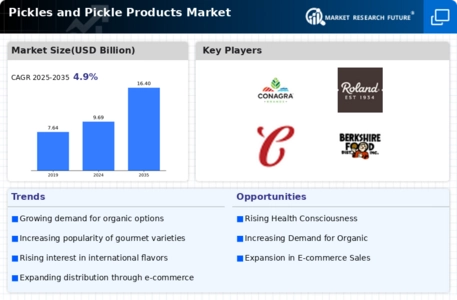Growth of Plant-Based Diets
The rising popularity of plant-based diets is emerging as a crucial driver for the Pickles and Pickle Products Market. As more consumers adopt vegetarian and vegan lifestyles, the demand for plant-based accompaniments, such as pickles, is likely to increase. Pickles provide a flavorful and nutritious addition to plant-based meals, enhancing their appeal among health-conscious consumers. Market analysis suggests that the plant-based food sector is expected to grow significantly, with projections indicating a potential market size increase of over 20% in the coming years. This trend is anticipated to positively impact the Pickles and Pickle Products Market, as consumers seek out products that complement their dietary choices.
Expansion of Retail Channels
The expansion of retail channels is a significant driver for the Pickles and Pickle Products Market. With the proliferation of supermarkets, specialty stores, and online platforms, consumers have greater access to a diverse range of pickle products. This accessibility is likely to enhance consumer awareness and stimulate demand for various pickle offerings, including organic and artisanal varieties. Recent statistics indicate that online grocery sales have surged, with e-commerce expected to account for a larger share of the food retail market in the coming years. This shift in shopping behavior is anticipated to benefit the Pickles and Pickle Products Market, as consumers increasingly seek convenient purchasing options.
Culinary Versatility of Pickles
The culinary versatility of pickles serves as a significant driver for the Pickles and Pickle Products Market. Pickles are not only consumed as standalone snacks but are also utilized in a myriad of dishes, ranging from sandwiches to gourmet salads. This adaptability enhances their appeal across diverse consumer segments, including health-conscious individuals and culinary enthusiasts. The market has witnessed a surge in innovative pickle products, such as flavored and spiced varieties, which cater to evolving consumer tastes. As a result, the market for pickles is expected to expand, with projections indicating a potential increase in sales volume by 15% over the next few years, further solidifying their role in the Pickles and Pickle Products Market.
Rising Demand for Fermented Foods
The increasing consumer inclination towards fermented foods is a notable driver for the Pickles and Pickle Products Market. Fermented foods are recognized for their probiotic benefits, which contribute to gut health and overall wellness. This trend aligns with the broader health and wellness movement, where consumers are actively seeking products that enhance their dietary habits. According to recent data, the fermented foods segment is projected to grow at a compound annual growth rate of approximately 8% over the next five years. This growth is likely to bolster the demand for pickles, as they are a staple in many diets worldwide, thus reinforcing their position in the Pickles and Pickle Products Market.
Increased Interest in Home Cooking
The growing interest in home cooking is a notable driver for the Pickles and Pickle Products Market. As consumers spend more time preparing meals at home, there is a heightened demand for ingredients that enhance flavor and preserve food. Pickles, with their unique taste and preservation qualities, are increasingly being incorporated into home-cooked meals. This trend is reflected in the rising sales of pickling kits and DIY pickle recipes, which have gained popularity among home cooks. Market data indicates that the home cooking segment is likely to see a growth rate of around 10% annually, which could lead to a corresponding increase in the demand for pickles and pickle products in the market.















Leave a Comment